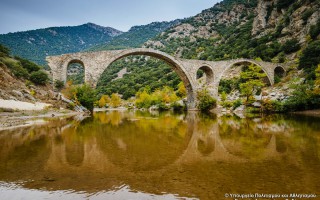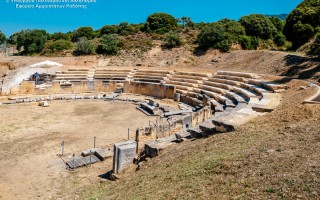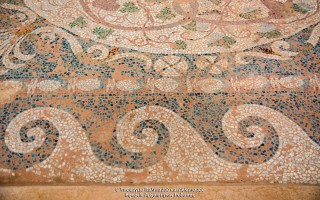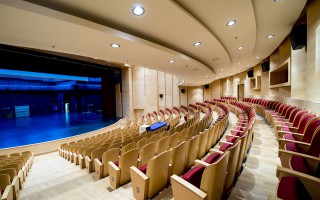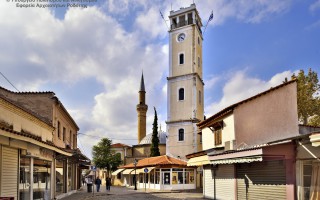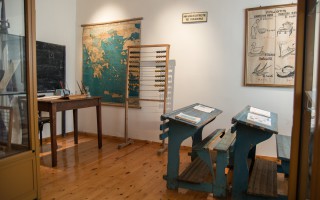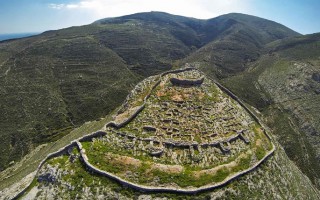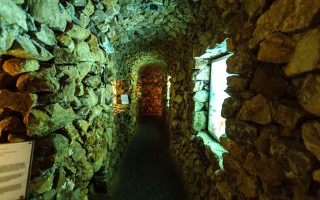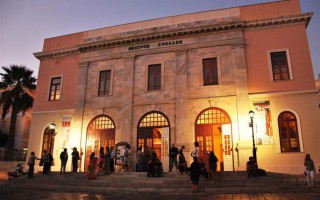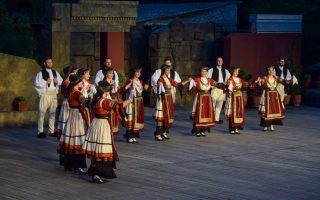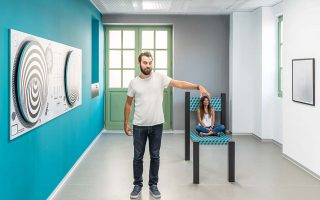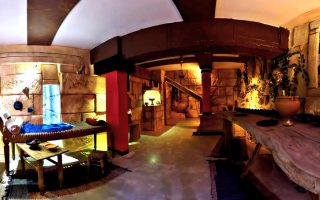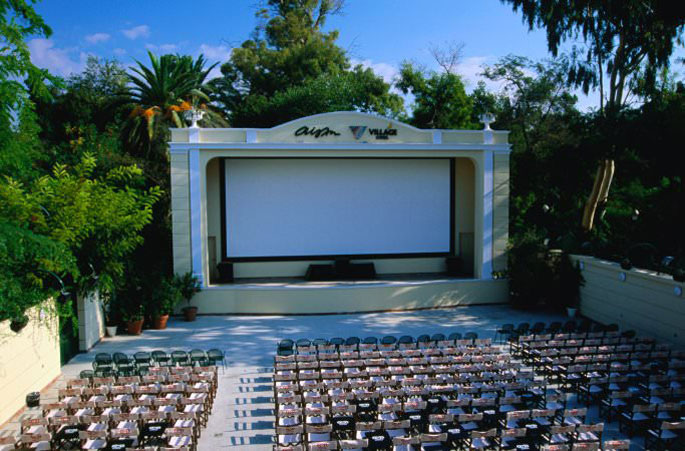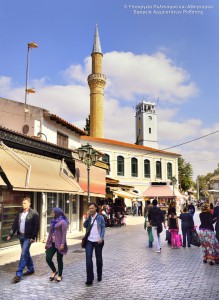 The Clock Tower was built in 1884, the era of Sultan Abdul Hamid B. In the decade of 1950 became architectural interventions and took its current form.
The Clock Tower was built in 1884, the era of Sultan Abdul Hamid B. In the decade of 1950 became architectural interventions and took its current form.
Behind the tower rises the minaret of the mosque of Yeni Mosque from the balcony where the muezzin calls the faithful of Islam to prayer. In the courtyard housed the religious authority of Muslims Rhodope, the Mufti of Komotini.
At the southwestern side of the assembly tower-mosque is the pedestrian shopping street of Ermou, while
the NE side, the traditional square of Hephaestus, is heaving laboratories tinplate, known teneketzidika, giving a unique color in the market town that lies around.
Source: Eastern Macedonia & Thrace
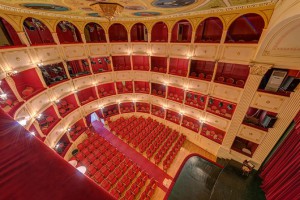 The historic Theater Apollon is one of the major attractions of Syros and constitutes an emblem of the island’s cultural heritage. Created in 1864 by the Italian architect Pietro Sampo who was inspired by 4 stunning Italian standards including the Scala di Milano, the theater Apollon adorns the heart of the capital to this day. The Apollo Theater first opened its doors with an Italian theater troupe that among others performances staged the famous Italian opera La Traviata. Its architectural splendor though did not manage to prevent the major catastrophes that the theater suffered over the years. The Apollon theater was forced to close and to spend a long period of renovations and interventions with funding from the state, with the full support of GNTO and the artistic supervision of Dimitris Fortsas as well as of the architect Peter Pikionis until 2000. Today the theater hosts various artistic and cultural events such as the Festival of the Aegean, famous plays and world-class performances.
The historic Theater Apollon is one of the major attractions of Syros and constitutes an emblem of the island’s cultural heritage. Created in 1864 by the Italian architect Pietro Sampo who was inspired by 4 stunning Italian standards including the Scala di Milano, the theater Apollon adorns the heart of the capital to this day. The Apollo Theater first opened its doors with an Italian theater troupe that among others performances staged the famous Italian opera La Traviata. Its architectural splendor though did not manage to prevent the major catastrophes that the theater suffered over the years. The Apollon theater was forced to close and to spend a long period of renovations and interventions with funding from the state, with the full support of GNTO and the artistic supervision of Dimitris Fortsas as well as of the architect Peter Pikionis until 2000. Today the theater hosts various artistic and cultural events such as the Festival of the Aegean, famous plays and world-class performances.
Cultural Events of Syros
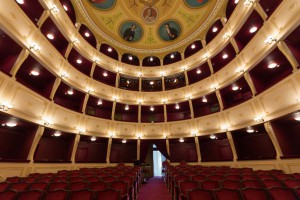 The Apollon theater hosts some of the most important cultural events, operas and amazing theatrical works from local and international theatrical troupes. Theater enthusiasts can find information on upcoming performances and learn about reservations and tickets for plays and events they wish to attend through the theater’s calendar of events. The Apollon theater also houses the Theater Museum or else “the memory place” founded in 2002. The Museum hosts findings from local and other artists who played an important role in the history of this monumental theater, a theater being the ultimate alternative for entertainment and unrivaled amusement on the island.
The Apollon theater hosts some of the most important cultural events, operas and amazing theatrical works from local and international theatrical troupes. Theater enthusiasts can find information on upcoming performances and learn about reservations and tickets for plays and events they wish to attend through the theater’s calendar of events. The Apollon theater also houses the Theater Museum or else “the memory place” founded in 2002. The Museum hosts findings from local and other artists who played an important role in the history of this monumental theater, a theater being the ultimate alternative for entertainment and unrivaled amusement on the island.
Theater website: www.apollontheater.gr
Source: www.syrosisland.gr
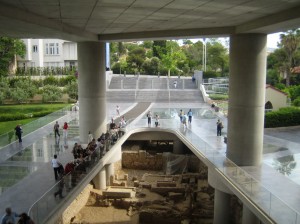 With a subway station conveniently located near its front entrance, the New Acropolis Museum contains the most important artefacts found on the “sacred rock.” Containing rare objects from the Mycenaean era to the Roman and early Christian ages, it is an absolute “must see” for visitors. Since Opening in 2009, millions of visitors have gazed in wonder at the Parthenon sculptures adorning its rooms. And, through the large overhead windows, visitors can simply look up to be overwhelmed by the sheer size and beauty of the ancient monuments towering above the museum.
With a subway station conveniently located near its front entrance, the New Acropolis Museum contains the most important artefacts found on the “sacred rock.” Containing rare objects from the Mycenaean era to the Roman and early Christian ages, it is an absolute “must see” for visitors. Since Opening in 2009, millions of visitors have gazed in wonder at the Parthenon sculptures adorning its rooms. And, through the large overhead windows, visitors can simply look up to be overwhelmed by the sheer size and beauty of the ancient monuments towering above the museum.
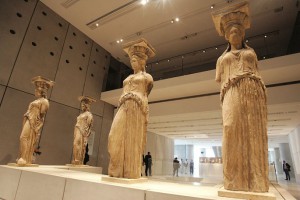 Replacing the old museum that had operated since the 19th Century in the building complex adjacent to the Parthenon. the New Acropolis Museum displays its invaluable collection of ancient artefacts with a modern twist; Built on high pillars directly above the Roman era archaeological site, visitors can look down through the transparent floors to view these rare artefacts. It is worth noting that since many of the principal exhibits require special lighting conditions to insure their preservation, the museum uses a substantial amount of natural light for its illumination.
Replacing the old museum that had operated since the 19th Century in the building complex adjacent to the Parthenon. the New Acropolis Museum displays its invaluable collection of ancient artefacts with a modern twist; Built on high pillars directly above the Roman era archaeological site, visitors can look down through the transparent floors to view these rare artefacts. It is worth noting that since many of the principal exhibits require special lighting conditions to insure their preservation, the museum uses a substantial amount of natural light for its illumination.
Museum web site: www.theacropolismuseum.gr
Source: www.athensattica.gr
The Olympic Athletic Center of Athens bares the name of the first winner of the Marathon in the first modern Olympic Games in Athens in 1896, the notorious Spyros Louis, who in fact was a simple waterman from Maroussi. The construction of the premises started in 1978 and the main Stadium and the other installations were inaugurated four years later to house the European Athletics Championship in 1982.
The following years a number of other sport facilities surrounded the Main Olympic Stadium: the Olympic Velodrome (inaugurated in 1991), the Olympic Aquatics Center (1991), the Olympic Indoor Sports Center (1995), the Olympic Tennis Center (2004), as well as other supplementary sport facilities. The Olympic Athletic Center of Athens is a state-of-the-art sports facility, which greatly promoted sports activities in Greece. The facilities were finalised in 2004, with the redevelopment additions by the Spanish architect Kalatrava, and the Stadium hosted the Athens 28th Olympic Games in 2004.
OAKA web site: www.oaka.com.gr
Source: www.athensattica.gr
The Jewish Museum of Greece was founded in 1977 by the Jewish Community of Athens. Housed in a room of the Synagogue on Melidoni street, this small museum contains objects that survived World War II; objects from the everyday lives of Greek Jews, mostly small works of art, historic documents and heirlooms. A large part of the original collection were items seized by the Bulgarians in Salonika, and returned to Greece by the Bulgarian Government after the war.
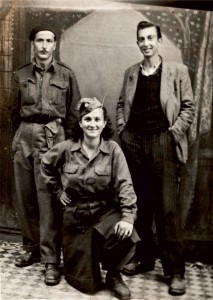 Over the years, a large volume of material was collected; rare editions of books, valuable fabrics, jewelry, religious and ornamental vessels, and simple, everyday objects. When the ever-increasing volume of exhibits demanded new, larger premises for the museum, the curators rented a floor in a building on Amalias street, which is now open to the public.
Over the years, a large volume of material was collected; rare editions of books, valuable fabrics, jewelry, religious and ornamental vessels, and simple, everyday objects. When the ever-increasing volume of exhibits demanded new, larger premises for the museum, the curators rented a floor in a building on Amalias street, which is now open to the public.
In 1989 the museum became a legal entity, administered by a seven-member council. In the 1990’s the museum’s current location on 39, Nikis street, was purchased and restored, and the museum moved in permanently.
Museum web site: www.jewishmuseum.gr
Source: www.athensattica.gr
In the late 1920s, architects E. Lazaridis and E. Dimitriades Rok designed the Monument of the Unknown Soldier. The relief figure on the marble tomb was sculpted by famed artist, Konstantinos Dimitriades. During the initial phases of its construction, prior to its final placement, extensive excavation was undertaken in front of the Parliament building, lowering the ground level by approximately 6 metres, to the level of Amalias avenue.
Heavily influenced by the archaic art style, the monument is strictly minimalist in design, its only modernist decorative elements being the bronze shields. The monument is guarded day and night by the Presidential Guard of Evzones, and is where officials dedicate wreaths in honour of the Unknown Soldier.
Source: www.athensattica.gr
The Egli Cinema is perhaps the oldest cinema still in operation in Athens. Opened in the early 20th Century, following a civil war and World War I, it is located on the premises of the “Egli Beer Restaurant,” which opened in 1904. The theatre’s close proximity to the Zappeion Mansion and its gardens, helps to augment this picturesque section of old Athens. The cinema, now part of the large Egli multiplex, with its restaurants, bars, coffee-shops, and event venues, is considered by summer cinema lovers, to be one of the best places for entertainment in Athens.
And, though located in the very center of Athens, it is virtually free from the usual noise associated with bustling cities. Surrounded by lush greenery, complemented by the perfume of summer flowers, it even has a “private” veranda, from which, you can watch your favorite movies, while enjoying a great dinner.
Cinema web site: www.aeglizappiou.gr
Source: www.athensattica.gr
The National Theatre on Agiou Konstantinou street, near the Omonia square, was built to meet the city’s need for a new theatre. Designed by Hernst Ziller and constructed from 1891 to 1901, the project was initiated by King Georg I.
Located on a small lot purchased by Bavarian courtesan, Thonn, private funding for its construction was supplied by a large number of wealthy Greek patrons, most of them from the diaspora; Rallis, Korgialenios and Evgenidis. Despite the challenges posed by the small size of the property and the extreme land gradient, the architect delivered a splendid building of the Eclectisistic order, a truly magnificent theatre, containing two full stages and a large lecture room. The National Theatre is admired by Greek and international audiences alike.
The National Theatre web site: www.n-t.gr
Source: www.athensattica.gr
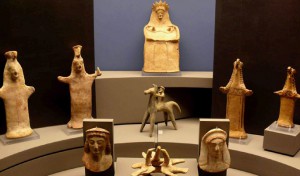 The Stathatos Manor in Kolonaki, is located at the junction of Vasilissis Sofias and Irodotou 1 streets, where it houses a wing of the Cycladic Art Museum. Built in the late 19th Century by famous architect, Hernst Ziller, the manor was based on plans drawn in 1895 for an expatriate merchant from Ithaca by the name of Stathatos, who, along with his wife, used the manor as their residence. During the 1930’s the building saw extensive alterations and a complete interior renovation.
The Stathatos Manor in Kolonaki, is located at the junction of Vasilissis Sofias and Irodotou 1 streets, where it houses a wing of the Cycladic Art Museum. Built in the late 19th Century by famous architect, Hernst Ziller, the manor was based on plans drawn in 1895 for an expatriate merchant from Ithaca by the name of Stathatos, who, along with his wife, used the manor as their residence. During the 1930’s the building saw extensive alterations and a complete interior renovation.
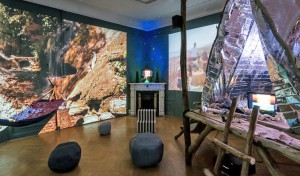 After World War II it was used as an embassy, until 1981 when it became the property of the Hellenic State. The Government initially intended to convert the building into a guest-house for distinguished visitors, so the manor was again fully refurbished, this time being restored to its original design. It was eventually assigned to the Cycladic Art Museum.
After World War II it was used as an embassy, until 1981 when it became the property of the Hellenic State. The Government initially intended to convert the building into a guest-house for distinguished visitors, so the manor was again fully refurbished, this time being restored to its original design. It was eventually assigned to the Cycladic Art Museum.
Museum web site: www.cycladic.gr
Source: www.athensattica.gr
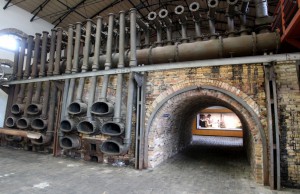 The Athens Gasworks factory, or “Gazi” as most people call it, is on the right side of Pireos Street, immediately past the entrance to Iera Odos. Built around 1860, the first plant was quite small and was owned by businessman, Frangiskos Feraldis. The small plant expanded rapidly, becoming an immense industrial complex. And though its general design mirrored the same architectural principles seen in similar industrial buildings throughout Europe, modernist decorative elements were also present, some displayed on the huge metal frames of the structures.
The Athens Gasworks factory, or “Gazi” as most people call it, is on the right side of Pireos Street, immediately past the entrance to Iera Odos. Built around 1860, the first plant was quite small and was owned by businessman, Frangiskos Feraldis. The small plant expanded rapidly, becoming an immense industrial complex. And though its general design mirrored the same architectural principles seen in similar industrial buildings throughout Europe, modernist decorative elements were also present, some displayed on the huge metal frames of the structures.
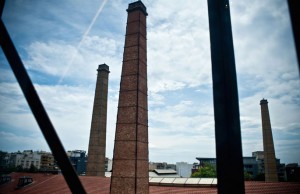 The plant was eventually sold to the Gas Lighting Company, and in 1938 it was acclaimed by the Municipality of Athens, finally ceasing operations in 1984. Today, the area has been fully refurbished and modernized into a “Technopolis-Gazi” cultural venue, home to various cultural events organized by the Municipality.
The plant was eventually sold to the Gas Lighting Company, and in 1938 it was acclaimed by the Municipality of Athens, finally ceasing operations in 1984. Today, the area has been fully refurbished and modernized into a “Technopolis-Gazi” cultural venue, home to various cultural events organized by the Municipality.
Technopolis site: www.technopolis-athens.com
Source: www.athensattica.gr





